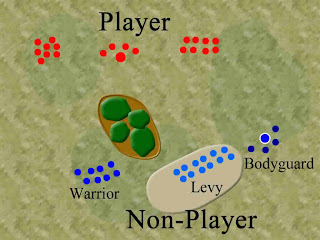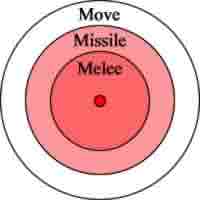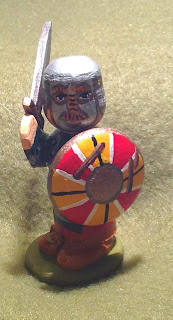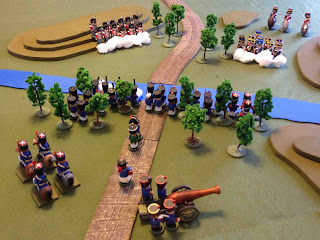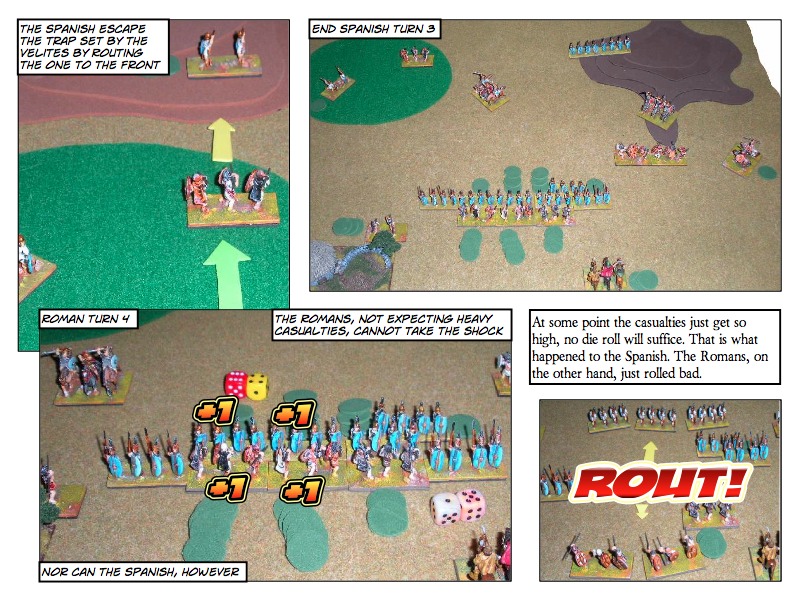As always, let me start by welcoming new readers
RSpears192,
Chris, and
Whiteface. Glad you've joined and hope you find some good ideas from what you read here.
So, I thought I would widen the reach of this blog and see if I could find other "hard core" solo gamers that want to explore mechanisms that make solo games more challenging, largely by trying to add "smarts" to the other side - a real programmed opponent. Instead, it created a flurry
1 of responses that ran the gamut of "why would you want to do that?" to "you are wrong".
So, looking at the description of the blog and I can now see that I am not all that specific, mostly because I am not so sure how long I can sustain the "exploration" part of my mission before this all just degenerates into a blog of battle reports of solo games. So, what is my intent?
My History with Solo Wargaming
I became aware of solo gaming at a very young age largely because no one wanted to wargame with me. I tried the "play both sides to the best of your ability" method and that quickly became boring. As time wore on I found a few classic books from Featherstone, Asquith, and Grant, but none of it really resonated with me all that much (at least at that age). By and large my only solution was face-to-face gaming.
When I got older I got into computers, and from there the concept of "artificial intelligence". Reading more about (albeit, not very deeply) that I realized that a large part of the problem was not understanding how we think and solve problems. That led to dabbling in expert systems and knowledge bases (again, not very deeply) and I realized that the key for
me cracking the solo gaming code was to start with understanding how
I make decisions. If I could not understand how I determined whether coming straight on was a better move than slowing moving around a flank through cover (or vice versa), then how could I write an interesting and challenging opponent?
Enter the Rules Database 2
The simplest concept was to start with a rules database. The thought process goes something like this:
- I will move this infantry unit straight forward it full 6" movement.
- Play that for awhile until a situation comes up that would force my unit to move into small arms range against an enemy unit in cover. Noting that the resulting exchange would be uneven and likely result in my unit losing, I think about how I reaction.
- New Rule: Exception - if the move will take the unit into small arms range of a unit in cover, and the moving unit will be in the open, the moving unit halts until another unit moves up in support. Both will then advance into firing range.
- And so on ...
An interesting approach, but many would say that you can never account for all contingencies with this method. Maybe, maybe not. After awhile you start to notice patterns. One exception says "woods" while another says "building", but they are largely the same, so you start combining the rules and refining the order of precedence. In the beginning, the model is very crude, but over time it gets smarter. Unless you are a really good organizer, however, it starts to get unwieldy and you have to stop adding exceptions. So there become deviations between where your model - your "programmed" opponent - acts differently (less intelligently) than you would because your mind can always assess more variables, quickly, than your rules database method can.
Enter Logic 3 and Real-Time Interpretation
This situation with the gap developing between the rules database and you leads you to start thinking about using an interpretive approach, such as
Mythic, where a set of rules govern using logic to interpret the situation real-time, and come to a decision. Whereas the rules database feels rigid (but consistent), real-time interpretation feels fluid, malleable, and if probability and chance are thrown in (as they are with
Mythic), less consistent. This lower level of consistency comes from two sources: the element of chance you've introduced, and the player's inherent bias.
Adding a random element will definitely lower consistency. After all, the reason you've probably injected chance is to create a sense of "surprise" or "unexpected behavior". Many solo gamers will tell you that bias towards one side or another always seems to creep in when the player has a choice, no matter how diligently he tries. Some people favor the underdog, while others favor who won historically. Some favor a side for national or ethical reasons. Some simply like how an interesting result is developing, which makes for a good narrative, and want to see that continue. Whatever the reason, when the player has the freedom to apply cold, hard logic, the "best" decision does not always result.
Enter the Charts
A compromise between these two methods are to use charts and dice. Using information culled from the rules database you can create charts that favor the most logical/"best" results, but still apply probability and random chance to inject a bit of surprise and unexpected behavior to spice things up. How complex you want to make those charts, and what you want to base the probabilities on, is largely left up to you. One interesting thought experiment (in a
previous blog entry) was to use a chart similar to
Two Hour Wargames' (
THW) reaction charts for determining how heavy infantry would advance upon the enemy. I stopped myself from using it in the
second playtest of Rally Round the King, but as I look over the materials that Ed kindly sent me, it is exactly that method that they use!
I was concerned that, by using the enemy's combat effectiveness rating (REP) to determine how good a move they made, I was unfairly injected "morale" as a factor. It is an interesting concept, but it seems to add an unaccounted for aspect to the game. It would certainly add a level of superiority of player-controlled forces, and that was one thing I was trying to avoid. I'll go more into
THW's new solo gaming mechanisms in a future blog. For now, suffice it to say that what I was proposing is exactly the direction
THW went, so it wasn't a bad idea...
What's the Plan?
In the end I found out that it was all about having a plan. The single most important factor was having a battle plan to execute for your programmed opponents. Whether that plan developed over the course of the game or whether it was pre-defined is less of a concern. The important thing is that the more of a plan you have, the fewer options need be considered by your decision making mechanism and the less interpretation needed of the results. (Again, I will show in a future blog how
THW has stepped up their game in this area, and where you might consider additional expansion.)
So ...
Where does this leave me? The original question was: what is my intent with this blog. It is certainly to explore all solo gaming mechanisms that I come across. I also intend to explore how to game solo with popular game systems that use different chance devices (like the series on
Memoir '44 where I explore card/hand management). But in the end I will always be most critical of those systems that have a simplistic definition of what a solo game entails. To me there is "casual" solo gaming, and "dedicated" solo gaming. The latter takes a bit more work, but in my experience, produces a much better experience for the solo gamer.
Footnotes
1 Well, the solo gamers equivalent of a "flurry". What do you expect from a niche within a niche?
2 Despite using the term
database, I am not necessarily referring to the use of a computer. Although I use a computer to type up the lists, I print them out on paper for use during games.
3 Not to imply that logic was not a part of previous processes.
Mail Call
Really it should be "Blog Comments Replies", but that doesn't sound as good.
Chris wrote:
I bought THW's Vietnam rules after being led to believe they were suitable for the solo gamer. Ultimately I found them no more so than many other rules. Sure, the reaction system takes care of that side of things, but as you say, it doesn't solve the problem of the enemy descisions beyond that. I think some sets have a simple list of behaviours for enemies though, but nothing detailed.
Chris, I think you might be interested in the next blog entry. I am going to review the solo gaming mechanisms that you now find in the newer
THW titles. I'm not saying go run out and buy it, but they have added some components that are interesting. I'll be looking at
Fire In Korea, which is a supplement to
NUTS!, Second Edition, and possibly doing a playtest using the new solo mechanics, but applied to Western Front 1944 (because I don't have any North Korean or Communist Chinese Forces figures). Somewhere along the way I'll get into movement distances and weapons ranges, and how they dramatically alter the complexity of solo gaming.
Nicholas Caldwell wrote:
This is a great series of articles and almost certainly a sale of Mythic for me as this is exactly the kind of story driven games that I prefer to play. (I liked your comment about why you play solo!) I'm growing increasingly dissatisfied with Two Hour Wargame rules, not least because they often fail to give adequate explanation and example of critical game concepts.
But one thing that has worked, more or less, is the PEF system. Do you have any ideas for using Mythic in conjunction with PEFs? I can see driving the movement of PEFs using Mythic and that might be superior to the THW system which sometimes leaves PEFs "stuck" in one place due to the limited options PEFs are given in the table.
I have found that, in the debate of rules writing, there are two camps: give me the guidelines and I will figure out the details, and (what I call) "tournament tight". The former rules are intentionally designed not to spell everything out, expecting the player to take "ownership" of their purchase and fiddle with the rules (because they figure you are going to do that anyway). The latter are rules that players can use for gaming tournaments as they leave little to the interpretation.
Unfortunately, although there are only two camps in my mind, there are three different types. The first two conform to the definitions above, but the third
thinks that it has all the bases covered.
That said I find that certain players like rules from one camp or the other, but rarely both. Neil Thomas, for example, specifically writes his rules leaving out details about how a unit pivots or wheels because those concepts are familiar to gamers and spending the time and space specifying it a bit of a waste. (That is an interpretation on my part from reading the introductions to his rules.)
THW seems to cater to those that like to fill in the blanks, at least that was my impression from a conversation with Ed.
I do not see why
Mythic cannot be used to determine the movement of Possible Enemy Forces (PEF), but as I don't know the rules for PEF movement in
FNG (I do for
NUTS!) I am hesitant to diagnose the problem. PEF movement in
NUTS! is chart driven and basically has results for halt, move straight towards the closest PEF, or move straight towards the closest of your forces, with an override to split a PEF (like cell division) if it starts within a certain distance of another PEF. (I like this last part as it gives the player the incentive to scout out PEFs before they get out of hand.) So, if you want to modify the movement rules for PEFs by using
Mythic the question becomes one of "Why? What are you trying to get out of it? A better move, where the PEF uses cover to creep up on your forces?" If it is that, I would simply alter the movement rule that states it moves in a straight line for something more appropriate and challenging. Perhaps I am misunderstanding the question, or PEFs work differently in
FNG.
Danjou's Hand wrote (hah! good pun):
Honestly, I think the best location for the kind of thoughtful exploration and development of solo mechanisms that you're doing here is the pages of Lone Warrior. But, I don't think I could wait 3 months to read your next installment!
I think the medium of printing on paper and mailing it out is largely failing; I think this medium is the way to go. That said this same suggestion was made by a regular contributor of
Lone Warrior on the Solo Wargames forum and my answer remains the same: this expression is an exploration, not a developed thought. By testing while writing it actually triggers certain mental processes in me that can lead off in a direction I did not expect to go. Further, this medium is superior in many ways, with hyperlinks, embedded images that can be clicked for a higher resolution version, and so on. Finally, it is somewhat interactive; more so than letters to the editor several issues after the article first appeared.
Whiteface wrote:
There is one problem with creating own decision / reaction tables. They will contain way too many details and possible situational modifiers. It's not that easy to keep them short & simple.
I think I have addressed this response in this entry. In fact, it served as inspiration for some parts.
I am not really a "short and simple" guy. I don't think that "short" always leads to simple, nor "long" necessarily leads one away from it. I do think that there is a breaking point in this concept, however, but it differs for each person depending upon their love for detail (and complexity!).
Given each person's differing acceptance levels for detail I have intentionally avoided providing specific solutions and kept it at the conceptual and descriptive level. I know this sounds somewhat hypocritical of me, given that I complain about a lack of detail or a particular implementation from others, but I am not writing rules for publication (or sale); I am an ideas guy trying to it all out for myself.
Nicholas Caldwell wrote:
"Sometimes I feel like the reaction results do not have enough granularity of result; it sometimes feel like all or nothing" [quote from my blog]
Could you explain this a bit more? The example that comes to my mind is a "break" test -- my unit has suffered casualties, does it run away? Most game systems treat this as a binary decision -- is RRtK any different in that regard? Or is it a different reaction test that feels "all or nothing"?
This has been an excellent series and I have keep returning to re-read. Here are some of the items that I've been cogitating on:
1) I'm increasingly dissatisfied by THW games. They seem to me to be a toolbox to create your game rather than a complete game. Your comments about the fiddly-ness of the movement in RRtK seems to be a good example of that. I too am trying out RRtK and will see how it goes -- but I also just purchased Fields of Glory and it is calling strongly. No doubt part of this is just due to the clarity of the writing (which THW always struggles with).
2) I am very interested in artificial life and it seems to me that the research there has direct bearing on what we are trying to achieve -- namely, that simple rules can lead to complex behaviors. The Flocking Rules describing the movement of birds is a good example (http://en.wikipedia.org/wiki/Flocking_(behavior)#Flocking_rules). I wonder if something similar could be applied to our artificial opponents in wargaming?
Generally, we want our opponent to act "sensibly" but we also want "surprises". With a game like RRtK, most of those decisions are made in setup as you indicated with the article on the use of Mythic. So, take a heavy infantry unit. "Sensibly" I want this unit in the center of my line facing the opponent's heavy infantry unit. So a rule for Heavy Infantry might be "Attack the strongest" or "Attack the Weakest". I think this is similar to where you were heading with coming up with tables driven by the Rep values -- maybe we're thinking along the same lines.
Granularity of result is just what you suggest: having more than two possible results (such as your example break or stand).
RRtK does provide more than a binary result in most cases, but I suppose I was thinking about how many more could there (or should there) be.
Wow,
Fields of Glory (
FoG) is so far opposite in the spectrum to
RRtK it is hard to compare. The number of figures and units in use, the amount of time required to complete, the level of detail to track; practically nothing is comparable about those two rule sets.
It is easy to start with rules like
RRtK because they have a strong command and control element aimed squarely at the player making the best of a situation where he loses control. If I remember correctly, the level of control the player has in
FoG is very high. Granted, if you fail a maneuver or morale roll the units doesn't perform as expected, but that is true with most rules. Although it is hardly impossible to play
FoG solo, the increase in decisions and control points that the player has will make it harder to stick to more rigid decision making mechanisms like charts and rules databases.
What I have taken away from the computer world for solo gaming is the concepts found in expert systems, where one lays down a rules database and evaluates rules in order of precedence until a match is found (the IF condition is met and the THEN clause is executed), at which point you stop evaluating rules. I find this very usable as a player familiar with his own creation will soon be able to move down the list quickly to find the one that will trigger.
Ideas like using flocking rules certainly might have merit for study and application. I can see using something like that to allow a player to move groups of figures or units, rather than a single entity, in an intelligent fashion. It will probably be the next leap forward for solo gamers. Now how to harness it ...
The REP-driven tables are a bit problematic. Essentially what the system is portraying is that two passes equals the best move you can think of for a given situation, one pass equals a less optimal move, and zero passes equals an even less optimal and possibly a bad move. It would be hard to convert to get results of optimal moves versus surprise moves. Even more problematic is that the odds of which type of move made is dependent upon the combat effectiveness (REP) of the unit. Low REP units tend to make more bad moves than optimal ones. Makes sense, but it creates a sense of "double jeopardy" with low REP units not only getting defeated in straight-up fights, but now more likely to enter into disadvantageous fights.
I do intend to explore this more, however, as this is the path
THW has taken to expand their solo rules.
Well, talk about a long entry. Probably time to wrap it up.
